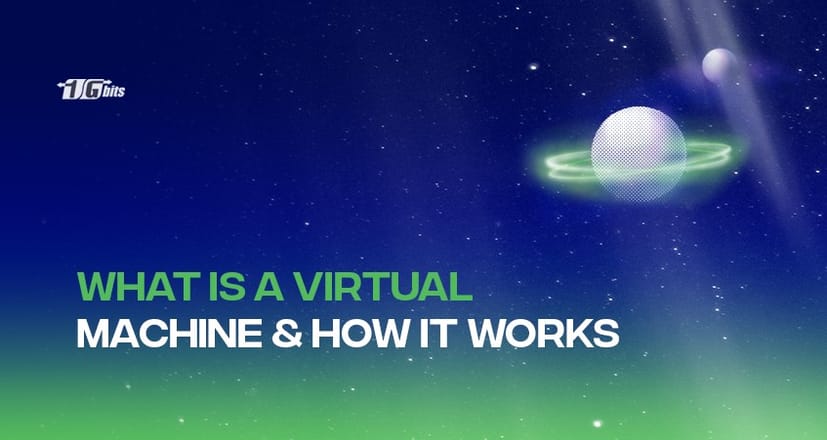What is a virtual machine? A virtual machine (or VM) is a resource that uses software instead of a physical device to deploy applications and run programs. VMs are generally used to test, run, or back up data In SaaS applications.
Before we begin to understand the concept of virtual machines in detail, it is vital to understand the integration of software and hardware in an operating system.
Let's begin!
Operating system
We use several gadgets in our day-to-day life. Right? Several electronic devices like smartphones, laptops, tablets, etc., run because of an operating system. Some of the most common and widely used OSes are Windows, Mac, Linux, Android, and Unix. Among these, Linux stands out for its flexibility, security, and open-source nature, making it a popular choice for both personal and enterprise use. To learn more about its features and why it's so widely used, check out our in-depth guide on What is Linux OS.
The operating system controls and manages the device's hardware to provide benefits to the user.
An OS is like the foundation that helps you to carry out several tasks in your day-to-day life. For instance, an operating system runs several other pieces of software. If you want to download any file, the OS has to filter out space on the hard drive for your file. Moreover, it also assists the web browser in the running and provides it with appropriate amounts of RAM for smooth operations.
Basically, there is only one operating system on a single device. But there are instances where the user needs more than one operating system on their device.
Can two or more operating systems on a single device fulfil that requirement question? Well, almost everything can be figured out in these technologically advanced times! So the answer is a yes. Let us show you how.
How do you have more than one operating system on one device?
The answer to this need is virtualisation. The process of virtualisation lets the software act as an independent device. The software we are talking about here is a virtual machine. It is sometimes called a guest computer too.
This is our core topic too!
With the concept of virtualisation, one device can manage two or more operating systems at the same time. The number of virtual machines (VM) that can run on a single host depends on the available resources by the host.
There are several types of virtualisation. Let us study them first!
Types of virtualisation
- Hardware virtualisation
- Software virtualisation
- Network virtualisation
- Storage virtualisation
- Desktop virtualisation
Hardware virtualisation: We create virtual versions of operating systems and computers in hardware virtualisation. They are then amalgamated into a single primary server.
Software virtualisation: software virtualisation helps you create a computer system with the hardware that permits more than one operating system to manage and run on a physical host (like KVM). For more details on KVM, check out our guide on What is the KVM Virtualizor to better understand how this popular virtualization technology works.
Network virtualisation: you can create various sub-networks on the same physical network by merging the equipment into a single virtual network resource. If you run a company with a large number of users, it is a good choice for you as it results in higher security, great network speed, and increased reliability.
Storage Virtualisation: in storage virtualisation, you have the comfort of combining various physical storage devices and presenting them as a single storage device. It also helps in disaster recovery planning as the data can be easily duplicated and transmitted to another location.
Desktop virtualisation: This virtualisation bifurcates the desktop environment from physical devices. It further keeps a desktop on the remote server, allowing users to use their desktops from any location.
Now, moving on to the next segment, let us understand the uses of virtual machines!
Uses of virtual machines
There are abundant features and uses of virtual machines. We are listing a few of them that help you with greater accessibility and ease.
Take a look:
Testing: Virtual machines come to the rescue to test several applications in different environments. It is simple and cost-effective.
Run outdated software: Some fragments of software are not accessible in modern operating systems. If you wish to run these applications, you can do that on a virtual machine.
Software designed for other Operating Systems: A virtual machine can manage and run software specially designed for some other operating system. For instance, if you are a Mac user and want to run the software design, particularly for Windows, you can run Windows virtual machine on the Mac host (VirtualBox Mac).
Virtual machines can manage legacy applications, implying that the cost of migration to a new OS is cut. They also provide you with integrated disaster recovery.
Along with these some impressive features and advantages, there are also some disadvantages of virtual machines that you must know.
Disadvantages of virtual machines
As compared to physical computers, virtual machines are comparatively less efficient and slower. This is why most businesses use physical and virtual infrastructure together to maintain a balance.
Moreover, running several virtual machines on one physical device can result in some severely unstable performances.
Well, moving on to the next segment, there are two types of virtual machines. Read ahead to understand.
Types of virtual machines
- Process virtual machine
- System virtual machine
Process virtual machine: it permits a single process to act as an application on the host machine. A great example of a process virtual machine is the Java virtual machine, more commonly known as JVM. It helps to run Java applications on an operating system as if it was already a part of the system.
System virtual machine: when we talk about a system platform, it extends its support to sharing a host computer's physical resources with several other virtual machines. Every virtual machine has its copy of the OS. The virtual machine depends on a hypervisor or the top of an OS. The hypervisor runs on specific hardware.
Conclusion
As you have seen, virtual machines are computers that run inside other machines with the help of virtualization. Virtual Machine Hosting is a key aspect of this technology, allowing users to deploy and manage multiple virtual machines on a single physical server.
This article helps you gain a basic understanding of what a virtual machine is, its advantages, disadvantages, and several types. We also touch upon how Virtual Machine Hosting can offer scalability, cost efficiency, and flexibility for various computing needs.
We hope that the information assists you in grasping the concept in the best way possible.
People also read:






